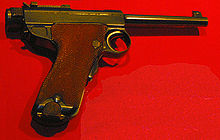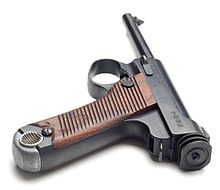Nambu pistol
| Type 14 Nambu | |
|---|---|
 Nambu Pistol Model 14 (1925) | |
| Type | Semi-Automatic Pistol |
| Place of origin | |
| Service history | |
| In service | 1906-1945 |
| Used by | See Users |
| Wars | Second World War, Second Sino-Japanese War, Chinese Civil War |
| Production history | |
| Designer | Kijiro Nambu |
| Designed | 1902 |
| Produced | 1906 - 1945 |
| No. built | 10,300 (Type A, all variants) 279,000 (Type 14) |
| Variants | Type A, Type B, Type 14 |
| Specifications | |
| Mass | 900 g (1.98 lb) unloaded |
| Length | 230 mm (9.06 in) |
| Barrel length | 117 mm (4.61 inches) |
| Width | 720 g |
| Cartridge | 8×22mm Nambu |
| Caliber | 8 mm |
| Action | recoil-spring |
| Muzzle velocity | 950 ft/s (289.6 m/s) |
| Effective firing range | 50 m |
| Feed system | 8 round box magazine |
The Nambu pistol (南部拳銃 or 南部大型自動拳銃, Nanbu kenjuu or Nanbu ōgata jidou-kenjuu) was a series of semi-automatic pistol produced by the Japanese company Koishikawa Arsenal later known as the Tokyo Artillery Arsenal.[1] The series had three variants, the Type A (also called the Type 4), the Type B (also known as the Baby Nambu) and the Type 14 (南部十四年式自動拳銃). The pistols were designed by Kijiro Nambu and saw extensive service during the Russo-Japanese War, Second Sino-Japanese War and World War II.
History
The origins of the Nambu pistol series goes back to a design by Lieutenant General Kijiro Nambu.[2] General Nambu claimed the design originated with experimentation during the "30 year Automatic Pistol Plan" of 1897 in Japan.[1] It is more probable that the pistol series was influenced by the Mauser C96, after a Japanese commission toured Europe and reported recent developments. The first Nambu type known as the Type A was completed in 1902.[1] The Type A underwent trials with the Imperial Japanese Army but was never formally adopted.[1] Many Original Type As were sold commercially to China and Siam.[1] Coinciding with British customs, Japanese army officers were expected to purchase their own side arms.[2] The Nambu Type A pistol was adopted by the Imperial Japanese Navy in 1909 and the Thai Army in the 1920s.[2]
Most of the Type A and Type B Nambu pistols were produced by the Tokyo Arsenal with a few pistols being produced by the Tokyo Gas and Electric Company.[1] The Type 14 Nambu was produced by the Nagoya Arsenal in either Nagoya's Atsuta or Toriimatsu factories.[3]
The pistol was retired from service when Japan was disarmed after World War II. Many were taken home by Allied servicemen as war trophies after World War II. Many have found their way into collectors markets in America and western Europe.
Common Design
The Nambu pistol series is a recoil operated, locked breech, semi-automatic pistol. The pistols are slender barreled with a single piece frame.[1] The barrel is forged integrally with the receiver.[1] The breech-lock was achieved by a propping system similar to the breech lock system used in the Glisenti Model 1910.[4] As the barrel moved forward, the block would be lifted as it rode across the frame forcing the lug upward to lock into the bolt.[2] The Nambu series is well balanced despite the main spring chamber protruding from the left side.[1]
The Nambu pistol uses a low pressure 8 mm cartridge, which is considerably less powerful than comparable Western rounds like the .45 ACP, the 7.62x25mm Tokarev, the .455 Webley, and the 9x19mm Parabellum. The safety catch on the Type A requires both hands to operate; it was omitted entirely from the Type 14. The stock magazine springs on early models were too weak, which could result in jams.[5] On the positive side, the Nambu was accurate, and the low recoil of the 8 mm round contributed to this accuracy.
Type A

The original Nambu was the Type A, designed by General Kijiro Nambu in 1902. The Type A had two basic variants with the first group of Nambus produced between 1903-06 different than those produced after 1906.[3] Both the Tokyo Arsenal and Tokyo Gas and Electric Company ceased on the Type A Nambu in 1923.[3] The Nambu Type A outwardly resembles Luger P08 pistol but functionally is more similar to the Mauser C96.[3]
Original Type A Nambus produced have multiple variances from later Type As. The trigger guard of the original Type A Nambu was considered extremely cramped especially when wearing gloves and was enlarged in later produced models.[3] The original Nambus also had a wooden bottom magazine and welded lanyard loops.[3] Later productions had aluminum bottomed magazines[6] with lanyard loops retained in rings.[3]
Type B
| Type B Nambu | |
|---|---|
| Type | Semi-Automatic Pistol |
| Place of origin | |
| Service history | |
| Used by | Imperial Japanese Army |
| Wars | Second Sino-Japanese War, World War II |
| Production history | |
| Designer | Kijiro Nambu |
| Designed | 1909[1] |
| Manufacturer | Koishikawa arsenal |
| Produced | 1909 to c1929[3] |
| No. built | around 6,000[4] |
| Specifications | |
| Mass | 650g (23 oz) Unloaded |
| Length | 171mm (6.75 in) |
| Barrel length | 83mm (3.25 in) |
| Cartridge | 7×20mm Nambu |
| Action | Short recoil, locked breech |
| Muzzle velocity | 290m/s (950 ft/s) |
| Feed system | 7-round detachable box magazine |
| Sights | Open Notch Rear[1] |
The Type B Nambu was a three quarters sized scaled down version of the Nambu Type A.[4] The Nambu Type B was produced because the Type A was felt to be too cumbersome and sold poorly.[4] It is commonly referred to as the Baby Nambu in Western Markets because of its small size.[7] It fired a smaller 7 mm round than the conventional 8×22mm Nambu. The first 450 Type Bs had a wooden magazine bottom and single diameter firing pin but later Type Bs were produced with an aluminum magazine bottom and multiple diameter firing pin.[1] Nearly all Nambu Type Bs were purchased privately by Japanese Officers but never achieve popularity as they were twice the price of comparable imported pistols.[3] Koishikawa factory stopped parts production in 1923 after the 1923 Great Kantō earthquake but assembly continued until 1929.[1]
Type 14

The "Type 14 Nambu" was designed in 1925 with the goal of simplifying manufacturing to reduce cost.[6] It was officially adopted for issue to non-commissioned officers in the Japanese Army in 1927 and was available for purchase by officers.[6] The Type 14 was an improved version of the Type A Nambu. The Type 14 has similar About 279,000 Type 14s were produced. Later production models are distinguished by an enlarged, oblong shaped trigger guard (which was introduced after Japanese soldiers reported difficulty in accessing the trigger while wearing gloves in the cold Soviet far east) and sometimes have a knurled steel cocking knob instead of the standard "slotted" cocking knob. The redesigned cocking knob was implemented in 1944 in order to simplify production. The Type 14 also lacks the grip safety used on the previous models.
One quality of the Type 14 caught the eye of William B. Ruger who had acquired a captured Nambu from a returning U.S. Marine, shortly after World War II ended in 1945.[5] Ruger duplicated two Nambus in his garage,[8] and although he decided against marketing them, the handgun's rear cocking device and the Nambu's silhouette was incorporated into one of the most popular .22 semi-automatic pistols to ever enter the U.S. firearms market, when in 1949 the Ruger Standard (and later Mark I, II, and III) pistols were sold to the American public.[5]
Users
Notes
- ^ a b c d e f g h i j k l m Hogg, Ian, Pistols of the World 4th Edition (2004) p. 191
- ^ a b c d e f McNab, Chris, The Great Book of Guns (2004) p. 124
- ^ a b c d e f g h i Hogg, Ian, Pistols of the World 4th Edition (2004) p. 232 Cite error: The named reference "pow2" was defined multiple times with different content (see the help page).
- ^ a b c d Hogg, Ian, Military Small Arms of the 20th Century 7th Edition (2000) p. 67
- ^ a b c John Whitt (2011). "Type 14 Nambu pistol". Retrieved 2011-02-03.
- ^ a b c Hogg, Ian, Military Small Arms of the 20th Century 7th Edition (2000) p. 66
- ^ Kinard, Jeff. Pistols: an illustrated history of their impact, p. 154, ABC-CLIO, Inc. 2003.
- ^ Wilson, R. L. "Ruger & His Guns; A History Of The Man, The Company And Their Firearms." 1996. ISBN 0-7858-2103-1.
References
- Hogg, Ian (2000). Military Small Arms of the 20th Century 7th Edition. Krause Publications. ISBN 0-87341-824-7.
{{cite book}}: Unknown parameter|coauthors=ignored (|author=suggested) (help) - Hogg, Ian (2004). Pitols of the World 4th Edition. Krause Publications. ISBN 0-87349-460-1.
{{cite book}}: Unknown parameter|coauthors=ignored (|author=suggested) (help) - Kinard, Jeff (2003). Pistols: an illustrated history of their impact. ABC-CLIO. ISBN 1-85109-470-9.
- McNab, Chris (2004). The Great Book of Guns. Thunder Bay Press. ISBN 1-59223-304-X.
- Japanese Nambu Type 14 pistol explained, Ebook by Gérard Henrotin (H&l Publishing - hlebooks.com - 2010)
